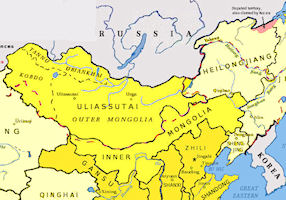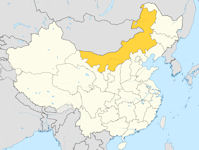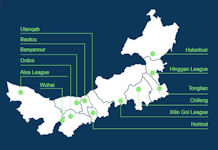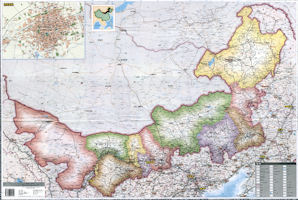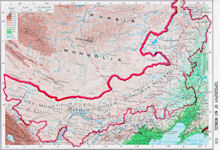Inner Mongolia Autonomous Region IMAR
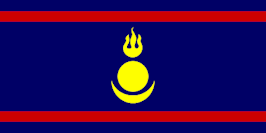 Mongols are on the verge of being completely overwhelmed in the IMAR by Han migrants and farmers, with the People’s Liberation Army also responsible for land expropriation, mainly as a result of various government policies, which directly or indirectly discriminate against Mongols. There are nearly 6 million Mongols in China, mainly concentrated in the Inner Mongolia Autonomous Region (IMAR) on China’s northern border with Mongolia and Russia. The modern country of Mongolia represents only part of the Mongols' historical homeland; today, more ethnic Mongolians live in the Inner Mongolia Autonomous Region in the People's Republic of China than in Mongolia.
Mongols are on the verge of being completely overwhelmed in the IMAR by Han migrants and farmers, with the People’s Liberation Army also responsible for land expropriation, mainly as a result of various government policies, which directly or indirectly discriminate against Mongols. There are nearly 6 million Mongols in China, mainly concentrated in the Inner Mongolia Autonomous Region (IMAR) on China’s northern border with Mongolia and Russia. The modern country of Mongolia represents only part of the Mongols' historical homeland; today, more ethnic Mongolians live in the Inner Mongolia Autonomous Region in the People's Republic of China than in Mongolia.
The Chinese Communist Party and the Chinese government decided to implement a policy to ban Mongolian language education completely starting September 2020. China's ruling Communist Party is to end Mongolian-medium education in the northern region of Inner Mongolia, which borders the independent country of Mongolia. The Chinese government ordered teachers to switch to Chinese-medium education from Sept. 1, the New York-based Southern Mongolian Human Rights Information Center (SMHRIC) said. WeChat discussions and posts on the changes, which are euphemistically referred to in official documents as "bilingual education," were deleted in large numbers, while hundreds of WeChat users received visits and warnings from state security police.
Mongolian students in elementary schools must start learning Chinese from first grade as opposed to second grade starting this September. Political studies will be taught in Chinese from Sept. 1 in Mongolian-medium schools with further subjects to follow in the next two years.
The new policy sparked immediate calls for independence for Inner Mongolia from China, including by ethnic Mongolian rights activist and former political prisoner Hada. "Even if this round of our resistance moment ends up with failure in the face of China’s brutal crackdown, the moment itself will help lay the firm foundation of our future movement for independence," Hada said in a statement posted online.
The Mongolians live mostly in the Inner Mongolia Autonomous Region, with the rest residing in Liaoning, Jilin, Heilongjiang, Xinjiang, Qinghai, Gansu, Ningxia, Hebei, Henan, Sichuan, Yunnan and Beijing. Having their own spoken and written language, which belongs to the Mongolian group of the Altaic language family, the Mongolians use three dialects: Inner Mongolian, Barag-Buryat and Uirad. The Mongolian script was created in the early 13th century on the basis of the script of Huihu or ancient Uygur, which was revised and developed a century later into the form used to this day.
The largest Mongolian area, the Inner Mongolia Autonomous Region with its capital at Hohhot, was founded on May 1, 1947, as the earliest such establishment in China. This vast and rich expanse of land is inhabited by 21,780,000 people, of whom about 2 million are Mongolians and the rest Hans, Huis, Manchus, Daurs, Ewenkis, Oroqens and Koreans. Mongols were a distinct minority at the founding of the autonomous region, though their proportion of the total population has risen slightly over time.
The Inner Mongolia Autonomous Region is located in the northern part of China. Covering 1.2 million square kilometers, taking up 1/8 of that of the country, and rising 900 to 1,300 meters above sea level, it has vast tracts of excellent natural pastureland with numerous herds of cattle, sheep, horses and camels. The Yellow River Bend and Tumochuan plains, known as a "Granary North of the Great Wall," are crisscrossed with streams and canals.
Hohhot is the capital of Inner Mongolia and the political, economic, scientific and cultural center of the region and is recognized as one of China's better-known historical cities. The name Hohhot is Mongolian for "green city". It is known as a national forest city, a model tourist city, one of the global Top 20 for economic growth, China's Top 100 for economic strength, and China's Top 50 for investment and finance
The Region is bitterly cold in winter and warm in summer. The average annual temperature is in the range between -1°C and 10°C (30.2°F and 50°F). In January, the coldest month, the average temperature ranges from -23°C (-9.4°F) in the north-eastern part of the Region to -10°C (14°F) in the south-western part; in July, the warmest month, the average temperature ranges from 19°C (66.2°F) in the north-eastern part to 24°C (75.2°F) in the south-western part. The temperature in the northern part is lower on the average than in the other places. The frost-free period varies from 90 to 160 days, and the average annual precipitation is between 50mm and 450mm, mostly in late summer and early autumn.
Over southwestern Inner Mongolia flows the Yellow River, which is, among other things, famous for its carp and the well-developed irrigation and transport facilities it has provided for the area. Inner Mongolia also has several hundred richly endowed salt and alkali lakes and many large freshwater lakes, including Hulun Nur, Buir Nur, Ulansu Nur, Dai Hai and Huangqi Hai. More than 60 mineral resources such as coal, iron, chromium, manganese, copper, lead, zinc, gold, silver, tin, mica, graphite, rock crystal and asbestos have been found.
The Greater Hinggan Mountain Range in the east part of the region boasts China's largest forests, which are also a fine habitat for a good many rare species of wildlife. This unique natural environment makes the region a famous producer of precious hides, pilose antler, bear gallbladder, musk, Chinese caterpillar fungus (Cordyceps sinensis), as well as 400 varieties of Chinese medicinal herbs, including licorice root, "dangshen" (Codonopsis pilosula), Chinese ephedra (Ephedra sinica), and the root of membranous milk vetch (Astragalus membranaceus). Specialities of the region known far and wide are mushrooms and day lily flowers, which enjoy brisk sales on both the domestic and world markets.
The Traditional cuisine in Inner Mongolia takes beef and mutton, and particularly the latter, as its main ingredient. Among the famous dishes is barbecue lamb, roast tenderloin of lamb, roast leg of lamb, kebab, boiled mutton or whole lamb. The instant-boiled mutton in hot-pot to go with Zhaojun rice wine and sesame pancakes is a well-known delicious course usually served in winter. Mutton eaten by hand is Hohhot's most famous dish. People use their hands to eat big chunks of mutton that are boiled in water and often hold the bones in one hand and use the other to pick the meat off and dip it in seasoning. This dish is often used as a treat for guests.
Roast whole lamb is traditionally offered for special guests and often appears only for grand occasions, such as important meetings or weddings. The lamb skin is a glittering golden color and the meat is crisp on the outside and tender inside and suffused with a fresh smell.
The beef courses are mostly braised or roasted. There are braised ox-tail, beef kebab, braised ox tendon, ox-tendon in egg-white, etc. Camel hoof with other delicacies is a dish that matches the taste of braised bear's paw and red-cooked or steamed mushrooms are real delicacies. The world-famous facia (a kind of edible algae), which means good omen and fortune to the native people, needs meticulous skill in preparing. It can be either cooked with meat made into vegetarian dishes, such as facia in egg-white and facia in casserole that unbelievable delicious. Braised elk's nose and crisp fried hazel grouse are all renowned delicacies. Following the founding of the Inner Mongolia Autonomous Region, autonomous prefectures and counties were established in other provinces where Mongolians live in large communities. These include the two Mongolian autonomous prefectures of Boertala and Bayinguoleng in Xinjiang, the Mongolian and Kazak Autonomous Prefecture in Qinghai, and the seven autonomous counties in Xinjiang, Qinghai, Gansu, Heilongjiang, Jilin and Liaoning.
Mongolians grow up on horsebacks and horses thus play an important part in their life. Every Mongolian loves to prove his worth by showing good horsemanship and archery as well as wrestling. "Nadam," meaning games in Mongolian, is the name of a traditional Mongolian fair, which is held in July and August each year. At the fair, people wearing their holiday best, participate in horse racing, archery, singing, dancing, chess playing and wrestling.
The life of the Mongolians is unique. Those in the pastoral areas wear fur coats lined with satin or cloth or nothing at all in winter and loose, long-sleeved cotton robes in summer. Mongolian costume is generally red, yellow or dark blue in color. A red or green waistband, flint steel, snuffbox and knife in an ornate sheath for cutting meat are accessories common to all men and women. Knee-high felt boots are a type of common footwear. Mongolians, men and women, wear cone-shaped hats in winter; they also like to wear silk or cloth turbans. Girls wear their hair parted in the middle, embellished with two large beads and agate, coral and green jade ornaments.
Founded in 1979, Inner Mongolia Erdos Investment Holding Group Co., Ltd. is a top 100 private enterprise in China. After more than 30 years of continuous profitability and continuous development, Erdos has developed from a cashmere processing enterprise into a large-scale modern comprehensive industrial group covering diversified operations such as cashmere clothing, resource mineral development and comprehensive energy utilization. Ordos cashmere industry is the leading cashmere textile industry in the world with perfect industrial chain and advanced technology. The National Cashmere Products Engineering Technology Research Center of the Group's scientific research base is a nationally recognized enterprise technology center and the only Chinese enterprise member of the International Cashmere Cashmere Manufacturers Association.
Under the PRC Regional Ethnic Autonomy Law, ethnic minorities have the right to use and develop their own languages, but other government regulations create conditions that stifle expressions of ethnic identity. Chinese provisions and measures require electronic bulletin board and Internet information providers to censor content deemed to jeopardize ethnic and national unity and to report attempts to post such materials to authorities.
Authorities in the Inner Mongolia Autonomous Region closed down an ethnic Mongol bulletin board service (BBS) in April 3006 after the BBS posted messages from "overseas separatists," while a Web hosting company shut down another site in Inner Mongolia the same month after it permitted online chatting in the Mongolian language, according to a May 11 report from the Southern Mongolian Human Rights Information Center (SMHRIC). The events follow the closing of two Inner Mongolian Web sites in September 2005 for allegedly posting separatist materials.
Under the ‘recovering grassland ecosystem’ policy of Chinese authorities, by which hundreds of thousands of Mongolian herders and their families are forcibly removed from their traditional pastoral lands. At a State Council meeting on grasslands policy in April 2011, authorities called for "more forceful policy measures" for "speeding up development of pastoral areas, ensuring the state's ecological security, and promoting ethnic unity and border stability," along with "a more vigorous employment policy" for "encouraging herders to change [modes of] production and occupations." In addition, central government authorities launched a system in 2011 to provide new subsidies and awards for abiding by grazing bans, which IMAR authorities reported implementing in May, according to a May 31 People's Daily article. In late 2010, an official in Xilingol stated that authorities would resettle at least 100,000 herders away from grasslands, while allowing 50,000 herders to stay in pastoral areas to "retain the traditional characteristics of the grassland culture," according to a November 6, 2010, Xinhua report.
Protests occurred in Inner Mongolia between May 23 and May 31, 2011, following two separate confrontations between workers from mining operations (some reportedly Han Chinese) and herders and residents near the mining operations (reportedly including Mongols and at least one Manchu), during which workers reportedly killed a herder and resident. Protesters called on authorities to prosecute the alleged murderers and also called for protecting herders' rights and Mongol culture. Authorities reportedly clashed with protesters in one case and have taken some protesters into detention. Authorities addressed some of the protesters' grievances but did not acknowledge a connection between the protests and official restrictions on Mongol culture. In the aftermath of the protests, security reportedly remains tight.
As authorities curbed protests and increased security in the region, official sources appeared to acknowledge some of the protesters' concerns stemming from the fights and murders earlier in the month, but they did not address broader grievances over curbs on Mongol culture. Authorities also cast blame on people deemed to agitate unrest, including overseas groups. In the aftermath of the protests, authorities reportedly continue to enforce a range of security measures, including widescale deployment of armed security and military forces.
|
NEWSLETTER
|
| Join the GlobalSecurity.org mailing list |
|
|
|


